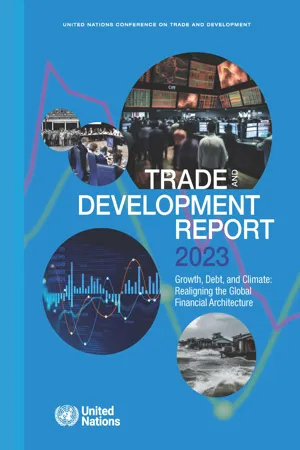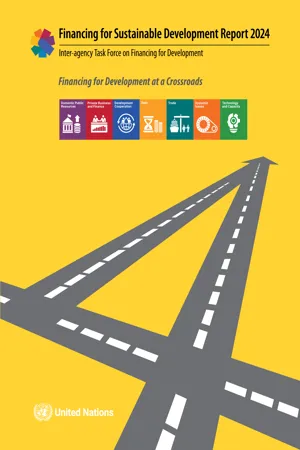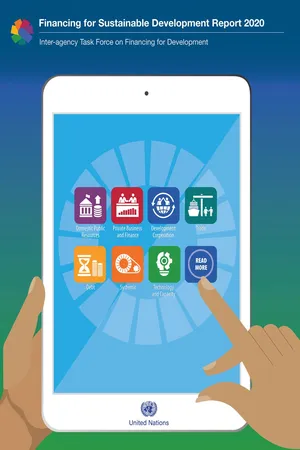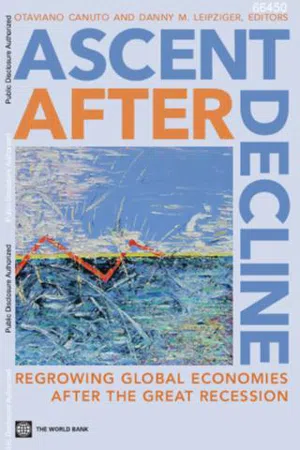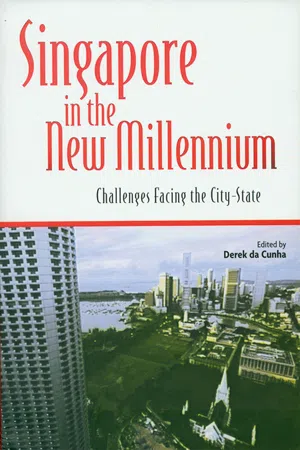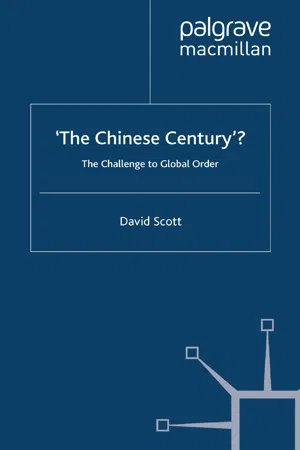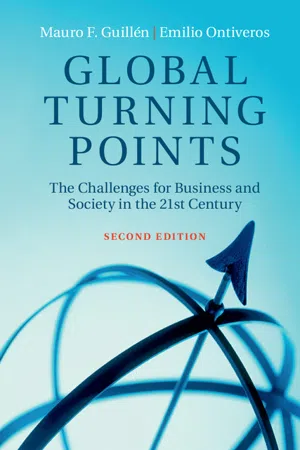Economics
Global Economic Challenges
Global economic challenges refer to the issues and problems that affect the world's economy as a whole. These challenges include issues such as income inequality, trade imbalances, financial instability, and environmental sustainability. Addressing these challenges requires cooperation and coordination among countries and international organizations.
Written by Perlego with AI-assistance
Related key terms
1 of 5
10 Key excerpts on "Global Economic Challenges"
- eBook - PDF
Trade and Development Report 2023
Growth, Debt, and Climate: Realigning the Global Financial Architecture
- United Nations Conference on Trade and Development (UNCTAD)(Author)
- 2023(Publication Date)
Chapter I Current Trends and Challenges in the Global Economy Current Trends and Challenges in the Global Economy Chapter I TRADE AND DEVELOPMENT REPORT 2023 Growth, Debt and Climate: Realigning the Global Financial Architecture 2 Crisis averted? How to future-proof against systemic shocks Today’s global economic landscape is characterized by growing inequalities and divergence of growth paths between key regions. The world economy is flying at “stall speed”, with projections of a modest growth of 2.4 per cent in 2023, meeting the definition of a global recession. Cautiously, the outlook for 2024 suggests a modest growth improvement (2.5 per cent), contingent upon the euro area’s recovery and the avoidance of adverse shocks by other leading economies. While many economies will grapple with divergent recovery paths, deepening inequalities and mounting pressures of indebtedness, global growth is unlikely to rebound sufficiently to pre-pandemic trends. This means that urgent needs like food security, social protection, and climate adaptation risk not being addressed. Compounding these issues is the absence of adequate multilateral responses and coordination mechanisms. Without decisive action, the fragility of the global economy and an array of diverse shocks risk evolving into systemic crises. Policymakers must navigate these challenges on multiple fronts to chart a more robust and resilient trajectory for the future. To avert tomorrow’s potential crises, this report urges policymakers to adopt a policy mix prioritizing the reduction of inequalities and the delivery of sustainable, investment-led growth and development. - eBook - PDF
Report of the Inter-agency Task Force on Financing for Development 2024
Financing for Sustainable Development Report: Financing for Development at a Crossroads
- Department of Economic and Social Affairs(Author)
- 2024(Publication Date)
- United Nations(Publisher)
27 Chapter II The global economic context and its implications for sustainable development 1. Introduction 27 At the midpoint for achieving the 2030 Agenda for Sustainable Development, the world economy lacks dynamism and is grappling with an array of risks and challenges. After a period of rapid economic expansion early in the millennium, the global economy’s momentum has waned, creating a challenging environment for financ- ing development. Global investment, trade and productivity growth have all decelerated amid a series of major crises and economic and non-economic shocks, from the 2007/08 food price crisis and the 2008 world financial and economic crisis to the COVID-19 pandemic and escalating geopolitical conflicts. Hard-earned development gains have been reversed, particu- larly in poor and vulnerable countries, which have yet to fully recover from the pandemic shock. These countries are also most affected by ever-increasing climate challenges that threaten to jeopardize people’s lives, health and productivity, and pose substantial economic tail risks. In this highly challenging environment, the global economic outlook remains fragile, with growth pros- pects subdued. The world economy avoided the worst-case scenario of a recession in 2023, with growth estimated at 2.7 per cent. But global growth, on a market exchange rate basis, is projected to slow to 2.4 per cent in 2024 before experienc- ing a moderate improvement to 2.7 per cent in 2025, i and is expected to remain weak in the medium term amid subdued investment and high levels of debt. Downside risks include: commodity price spikes and supply disruptions due to conflicts and further escalation of geopolitical tensions; a prolonged period of tight financing conditions; persistent inflation; and trade fragmentation. - No longer available |Learn more
Report of the Inter-agency Task Force on Financing for Development 2020
Financing for Sustainable Development Report
- Department of Economic and Social Affairs(Author)
- 2020(Publication Date)
- United Nations Publications(Publisher)
THE GLOBAL ECONOMIC CONTEXT AND ITS IMPLICATIONS FOR SUSTAINABLE DEVELOPMENT 1 Chapter I The global economic context and its implications for sustainable development * 1� Introduction In early 2020, the Inter-agency Task Force on Financing for Developing (Task Force) members lowered their already tepid growth forecasts due to rapid worldwide spread of COVID-19. Even in the most benign scenario, global growth is now expected to slow further in 2020, with a substantial risk of a global recession. significantly below the decade-low growth of 2.3 per cent in 2019. 1 The baseline outlook is subject to down- side risks and uncertainty, including a renewed escalation of trade disputes and a further rise in geopolitical tensions could also affect global growth in the short to medium term. Beyond these risks, the climate crisis continues to pose a rising threat to economic prospects. Without decisive policy action, there is a distinct possibility of a prolonged sharp slowdown in global economic activity. These challenges pose extremely serious risks to the timely implementation of the Sustainable Development Goals (SDGs). Subdued global growth was already setting back progress towards higher living standards. Before the outbreak of COVID-19, one in five countries—many of which are home to large numbers of people living in poverty—were likely to see per capita incomes stagnate or decline in 2020. This number will likely be higher due to economic disruptions from the pandemic. Existing economic vulnerabilities are being further aggravated by the impact of COVID-19 and related factors. Disruptions in industrial production are affecting global value chains and putting additional pressure on already weak trade and investment growth. Economic insecurity and job losses are impacting consumer demand. Rising volatility in financial markets could expose vulnerabilities in some economies with systemically important financial sectors. - No longer available |Learn more
Report of the Inter-agency Task Force on Financing for Development 2022
Financing for Sustainable Development Report: Bridging the Finance Divide
- Department of Economic and Social Affairs(Author)
- 2022(Publication Date)
- United Nations Publications(Publisher)
Chapter I 1 The global economic context and its implications for sustainable development 1 1. Introduction The global economic outlook remains highly fragile and uncertain, clouded by the war in Ukraine and continued pandemic risks. Beyond the worsening humanitarian crisis, the economic effects from the war in Ukraine are reverberating across the world. In many countries, the war has exacerbated supply bottlenecks and further fuelled inflationary pressures, leading to rising risks of stagflation. A possible pandemic resur-gence also remains a significant threat to the growth outlook of many countries. Monetary authorities are facing difficult policy choices amid a challenging environment. Even before the latest sharp increase in global oil and food prices driven by geopoliti-cal events, rising inflationary pressures had prompted many central banks to tighten monetary policy stances despite the highly uncertain economic recovery. However, a further tightening of global financial conditions—which might be compounded by a renewed “flight to safety”—could trigger sharp market corrections, leading to large capital outflows from developing countries and a surge in debt servicing costs. This would likely increase debt sustainability concerns and debt distress risks, and could prompt Governments to further tighten fiscal policies, which would further derail growth. 2 Growing headwinds to the global economy are compounding the risk of a lost decade for sustainable development highlighted in last year’s report. Compared to developed economies, the recovery from the pandemic has been weaker in developing economies, as reflected in larger output losses compared to pre-pandemic projections. Slower vaccination progress, a sluggish labour market recovery, limited fiscal space and tightening monetary conditions are among the key factors weighing on growth in developing countries. - eBook - PDF
Ascent after Decline
Regrowing Global Economies after the Great Recession
- Otaviano Canuto, Danny M. Leipziger(Authors)
- 2012(Publication Date)
- World Bank(Publisher)
Part I Diagnosing the Challenges 1 3 This volume examines one of the most fundamental questions to emerge from the Great Recession of 2007–09. What happens to economic growth going forward? Although all are painfully aware that some major economies are significantly below their growth potential and that it may be 2013 or 2014 before the global economy returns to normalcy, no one is sanguine about medium- to long-term growth prospects. For this rea- son, the challenging task of “regrowing growth” will take center stage for politicians and policy makers alike. The core concerns surround the damage to balance sheets, employ- ment, and confidence worldwide. Moreover, other elements of the future international economic landscape may fundamentally change the outlook for economic growth: Will international flows of capi- tal be encouraged or discouraged? How open will export markets be, given the potentially substantial structural changes underway and their implications for employment? And how much reliance will there be on market solutions when governments—now overly indebted and wary of additional relief expenditures—are expected to deliver on the promise of economic growth? How these pressing policy questions are answered will, in large measure, determine the future face of globalization. 1 by Otaviano Canuto, Danny M. Leipziger, and Brian Pinto The Challenges of Growth 4 Ascent after Decline One point is clear: without a resurrection of strong economic growth in major economies, the likelihood of rapid economic development in poor developing countries is dampened. 2 And even among the richer nations, the ability to manage debt is a direct consequence of overall economic robustness as epitomized by economic growth. The nature of that ascent is the subject of this volume. That the ascent will be a steep one can be surmised. How various elements will affect growth prospects is less clear but vitally important. - eBook - PDF
Singapore in the New Millennium
Challenges Facing the City-State
- Derek da Cunha(Author)
- 2002(Publication Date)
- ISEAS Publishing(Publisher)
26 2 EXTERNAL CHALLENGES FACING THE ECONOMY Raymond Lim Introduction Though economists may disagree about whether globalization today is unprecedented compared with an earlier period a hundred years ago, there is broad consensus that the trend in the new millennium is towards greater integration of national economies across factor and product markets, fuelled by the rapid developments in information and communication technologies. 1 Globalization and the information and communications revolution, and their effects on Singapore and the city-state’s responses to them, dominate discussions on the country’s economic future. They are the key external challenges. This chapter examines three aspects of this debate — financial liberalization, attracting foreign talent, and the role of government intervention in the Singapore economy. Financial Liberalization Global Casino Speculators may do no harm as bubbles on the steady stream of enterprise. But the position is serious when enterprise becomes the bubble on a whirlpool of speculation. When the capital development of a country becomes a by-product of the activities of a casino, the job is likely to be ill-done. 2 This chapter is reproduced from Singapore in the New Millennium: Challenges Facing the City-State , edited by Derek da Cunha (Singapore: Institute of Southeast Asian Studies, 2002). This version was obtained electronically direct from the publisher on condition that copyright is not infringed. No part of this publication may be reproduced, translated, stored in a retrieval system, or transmitted in any form or by any means, electronic, mechanical, photocopying, recording or otherwise, without the prior permission of the Institute of Southeast Asian Studies < http://www.iseas.edu.sg/pub.html > © 2002 Institute of Southeast Asian Studies, Singapore 27 External Challenges Facing the Economy Lenin was right. There is no subtler, no surer means of overturning the existing basis of society than to debauch the currency. - eBook - PDF
- (Author)
- 2011(Publication Date)
- Siber Ink Publishers(Publisher)
43 3 Globalisation Challenges Facing Developing Countries D M DAVIS 1. INTRODUCTION Leaving aside the undisputable constraints in the relation to nature (with global warming of obvious paramount importance), the other potential bar-riers of effective demand in the market place, of technologies and of geo-graphical/geopolitical distributions are likely to be profound, even supposing — which is unlikely — that no serious active oppositions to continuous capital accumulation and further consolidation of class power materialise. What spaces are left in the global economy for new spatial fixes for capital surplus absorption? China and the ex-Soviet bloc have already been inte-grated. South and South-east Asia are filling up fast. Africa is not yet fully inte-grated, but there is nowhere else with the capacity to absorb all this surplus capital. What new lines of production can be opened up to absorb growth? There may be no effective long-term capitalist solutions (apart from reversion to fictitious capital manipulations) to this crisis of capitalism. At some point quantitative changes lead to qualitative shifts and we need to take seriously the idea that we may be at exactly such an inflexion point in the history of capitalism. Questioning the future of capitalism itself as an adequate social system ought, therefore, to be in the forefront of current debate. 1 The term globalisation is so heavily contested that it induces hesitancy in any author who seeks a formulation of its core meaning, which in turn is necessary for any analysis of its implications for law and develop-ment in the 21st century. It would be a mistake to reduce globalisation simply to a process of market integration and even less so to some form of neo-liberal economic project based on open markets and free trade. - eBook - PDF
New Directions in Political Science
Responding to the Challenges of an Interdependent World
- Colin Hay(Author)
- 2010(Publication Date)
- Red Globe Press(Publisher)
They posed practical challenges to national governments, and regional and global institutions alike. They challenged a number of prevailing orthodoxies about what makes for effective economic governance. The recession, therefore, provides a particularly useful lens through which to view the state of the field of IPE. In this chapter, I first examine what recent developments have added to our under-standing of the forces of globalization, and the extent to which they constrain the policy options of states. I then turn to issues relating to the regulation of the global economy, the variety of forms of global gover-nance, and how responses to the recession might affect the balance between public and private regulatory authorities. Finally, I look at how recent developments in the global economy might impact on how we go about studying interdependence. Economic Interdependence and the Global Economic Crisis 151 Globalization: how new, how constraining? Globalization – which I understand as the forces (both economic and political) that have permitted the integration of economic space – has been the dominant metaphor in much of the literature of international political economy over the last two decades. Debate has focused on two broad sets of issues: first, is there anything new in the interdependence that characterizes the contemporary global economy; and, second, how constraining are the effects of globalization on states? The contemporary recession provides further strong evidence that the economic interdependence of the current period is unprecedented. It was the case that in previous major economic downturns, as might well be the case in the medium term with the current recession, less developed economies were frequently the worst affected – as happened, for instance, under the gold standard (Eichengreen 1985). - eBook - PDF
'The Chinese Century'?
The Challenge to Global Order
- D. Scott(Author)
- 2008(Publication Date)
- Palgrave Macmillan(Publisher)
51 3 China’s Economic and Environmental Challenges China’s economic development repeatedly hits the headlines, as ‘China’s explosive economic growth seems not just challenging, but terrifying. China, apparently, is set to sweep all before it’ (Hutton 2007: 329). The World Fair Exposition being hosted in Shanghai in 2010, the economic equivalent of the 2008 Beijing Olympics, will highlight China’s image as an economic heavyweight. Economic and environmental statistics feature heavily in this section, but it is the underlying trends, patterns, relationships, implications and consequences for the coming century that are the most important features to take account of. Mutual challenges lie between China’s supercharged ‘superpower economy’ (Tkacik 2007b) and the world. China and the world are looked at in turn vis-à-vis the other. China’s economic drive has become the central component of its foreign policy: ‘China’s foreign policy has largely been driven by immediate needs – access to economic markets and energy resources’ (Wolfe 2005). This will take us to the energy politics and general environ- mental issues coming into play between China and the world. 3.1 China’s economic challenges in the face of the world The post-Mao decades are the starting point for China in this century when the ‘Second Generation’ leadership of Deng Xiaoping initiated an ongoing economics-based programme, the famous Four Modernisations of the economy, science and technology, education and the military. The logic of ‘priority’ and of ‘time’ are involved. In terms of ‘pri- ority’, Deng Xiaoping explained the key role of economics clearly 52 ‘The Chinese Century’? enough: ‘without sound economic foundations, it will be impossible to modernize our national defence’; and at the widest level, ‘the role we play in international affairs is determined by the extent of our economic growth. - eBook - PDF
Global Turning Points
The Challenges for Business and Society in the 21st Century
- Mauro F. Guillén, Emilio Ontiveros(Authors)
- 2016(Publication Date)
- Cambridge University Press(Publisher)
The growing trade and fi nancial imbalances in the global economy pose serious threats to stability and governance. It is also important to note that, with only a few exceptions, emerging economies are provid-ing the fi nancing for the large current account and government de fi cits in the high-income countries. 10 A global economy out of balance Global encounters of the third kind We inherited from the twentieth century a rich legacy of international cooperation that made it possible for the global community to overcome the destruction and dislocation brought about by World War II. The legendary Bretton Woods agreements of 1944, which came into effect in 1947, facilitated economic and trade growth. For four interminable decades, however, the world remained divided into two competing political – economic blocs. Free markets supplemented by Keynesian policymaking ultimately won the battle over central planning. The momentum was strong enough to overcome the dif fi cult oil crisis of the 1970s, and globalization continued to grow even after the collapse of the orderly system of quasi-fi xed exchange rates. Trade and capital fl ow liberalization, especially as practiced by the most developed countries, widened the gap between capitalist and centrally planned economies. Economic backwardness combined with an aspiration for political participation and freedoms to produce the momentous break-down of Communist rule in Eastern Europe and the Soviet Union. We entered the twenty-fi rst century con fi dent in that free markets and dem-ocracy had demonstrated their superiority when it came to organizing societies and economies. A triumphant mood took over. The coming into effect of the World Trade Organization in 1995 was perhaps the crowning achievement of decades of tortuous negotiations to create a truly free global trading system.
Index pages curate the most relevant extracts from our library of academic textbooks. They’ve been created using an in-house natural language model (NLM), each adding context and meaning to key research topics.
